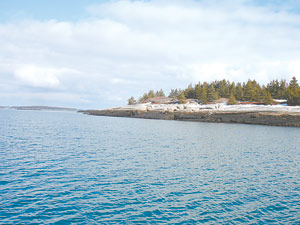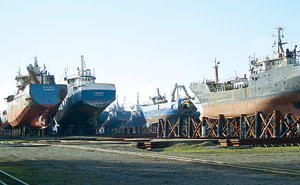 Off Drisko Island, Addisom, Maine where Phoenix Salmon US, Inc. has begun the process to lease a salmon production site. Jon Keller photo Off Drisko Island, Addisom, Maine where Phoenix Salmon US, Inc. has begun the process to lease a salmon production site. Jon Keller photo
|
At a January 26th scoping meeting in Addison, the Maine Department of Marine Resources (DMR) heard public comment on a proposed 20 acre salmon operation in Western Bay. Phoenix Salmon US, Inc. has begun the process to lease a sight between Drisko Island and Stevens Island.
Phoenix Salmon holds 8 leases in the state and is owned by the aquaculture giant Cooke Aqua- culture, a Canadian company that controls 28 of the 30 finfish leases in Maine. Cooke is a vertically integrated, “egg-to-plate” corporation with farms in Canada, the United States and Chile. They employ over 1,500 workers, and expect their 2009 sales to top $400 million. In 2004, Cooke took over Atlantic Salmon of Maine, and a year later, Heritage Sal- mon, which became Phoenix Salmon US. They also bought-out Marine Harvest’s operations on the east coast of Canada. With the economy in shambles, state and federal government and some local people are excited by the prospect of salmon aquaculture on Maine’s shores. Many hope the farms will be a rebirth of Maine’s working waterfront, and will breathe new life into the downtrodden downeast economy. Cooke’s new processing facility in Machiasport was recently welcomed with open arms, and with the federal government assisting corporations in their aquaculture pursuits, it seems that the Maine coast will indeed see more and more pens dotting their shores. But even as the pens arrive, the farms may not be the breath so many hope for.
* * *
Thirty years ago, on the other side of the world, salmon farms arrived on the coast of Chile. With government-support of the industry — and a sleepy coastal economy eager for jobs — the salmon industry eventually boomed. By 2007, yearly sales exceeded $2 billion. Chile became the 2nd largest exporter of farmed salmon in the world (Norway is the first), and the largest exporter to the United States. An estimated 50,000 workers were employed in the industry.
Then things changed.
Last year, infectious salmon anemia (ISA) hammered the farms. With millions of dead fish and toxic waters, industry began to search for clean pen sights, and they moved away. But the virus followed. Thousands of workers were laid off. The industry dropped by 30% or more. Another year of hardships is expected.
 The Chilean government backed the development of their big corporate herring fleet. They suplied their growing salmon farm industry. The herring stocks collapsed, the ships were stored on land, and disease wiped out the salmon. Paul Molyneaux photo The Chilean government backed the development of their big corporate herring fleet. They suplied their growing salmon farm industry. The herring stocks collapsed, the ships were stored on land, and disease wiped out the salmon. Paul Molyneaux photo
|
“In Chile, the situation is dire right now,” said Jose Villalon, the Managing Director of Aquaculture for the World wildlife Fund WWF in the US. It happens fast. In 2008, the Norwegian company Marine Harvest was raising 35 million fish per year in Rio Blanco, Chile. Within nine months of discovering the virus, they closed 14 of 60 operations and laid-off 1,200 employees. That’s 1/4 of its Chilean operations. The company then announced plans to move to cleaner, yet unspoiled waters. Locals were left with no jobs and polluted resources. Fishermen who once landed upwards of 1,000 pounds of fish a day had dropped to under 100 pounds, and claimed that the flesh of the robalo had begun to turn the rosy color of salmon due to the additives in the salmon feed. Then there were the chemicals, the antibiotics and the pesticides like emamectin benzoate, oxolinic acid, flumequine…(For a list of drugs approved for aquaculture: www.fws.gov/fisheries/aadap )
* * *
That’s the worst-case scenario. That’s Chile, not the United States. Not Maine. There are only thirty finfish leases in Maine right now, and as DMR Aquaculture Hearings Officer Diantha Robinson said, “There’s a lot of scrutiny by not only state agencies, but federal agencies as well.”
But the promise of government scrutiny doesn’t appease the way it should. Government oversite has failed to restore groundfish to New England waters. The federal government (via the Department of Commerce and the Department of Agriculture) has been a driving force in the finfish aquaculture industry, and their pervasive support of big industry is reminiscent of Chilean protocol. With a history as marred as the aquaculture industry’s, and traditional fishermen from Cobscook Bay west telling horror stories about salmon farms, many simply have no faith in either industry or government oversight.
“We act like they do, we get big fines,” said Richard Alley, a fifth-generation fisherman from Addison and a co-founder of the Downeast Fisherman’s Association. “They [the salmon farms] do whatever they want and no one seems to mind.”
“The bottom was all blue from the feces,” Alley said as he recalled diving on salmon pens, repairing holes in the nets. “If it wasn’t below it was to the east or west because of the current. The ocean’s not meant to have that kind of concentration of fish. That’s why the fish can swim.”
World Wildlife Fund is looking to mitigate that problem, and others. Called the “Aquaculture Dialogues,” WWF has been holding round-table meetings with producers, retailers, academics, NGO’s, and governments since 2004. Their aim is to compile a detailed set of global industry standards for finfish aquaculture by 2010. The standards will cover 10 varieties of finfish, and companies will be certified through a third-party process.
“Once the standards from these dialogs get out there, it’s going to be a good push to reform the industry,” said Villalon. “There’s big potential to transform the way aquaculture is done.”
Even so, Alley has reason to be defensive concerning the bottom around Drisko Island, the sight of the Phoenix proposal. He fishes a lot of traps there, as did his ancestors. “It’s not only my seventy traps,” said Alley. “It’s everybody else’s gear out there too. I haven’t found anyone who’s in favor of it [the lease].”
Existing fisheries are a consideration for lease sights, said Robinson. “The question is would aquaculture interfere with the existing fishery? The process tries to be stringent. We need evidence. How many people fish there? How many traps are there?”
But the environmental risks of salmon farms in the area aren’t the only problem that locals like Alley see. Phoenix Salmon US, Inc. is a foreign-owned company with a lot of potential to destroy resources while exporting profits.
“If anyone’s going to do it, I’d much rather see someone local, not some conglomerate out of Canada,” said Alley. “There’s kids growing up here and leaving because there’s no good jobs.”
Alley recognizes that salmon farms create jobs, but he says those jobs are low level and very little of the overall money trickles down.
“We don’t have jurisdiction on where the money goes,” said Robinson. “We’re part of a global economy.” Since 1997 there has been a 100-acre limit per lease, and a 500-acre limit in aggregate that any company can hold. Now it is still 100 acres per lease, but 1,000 acres in aggregate, with authority given to the commissioner to raise it by rule to 1,500 acres.
Finfish aquaculture is an expensive enterprise, and one of the aspects considered in a finfish application is the financial and technical capability of a company—something beyond most local peoples means.
As a reaction to past ISA problems in Maine, millions of dollars of federal money were funneled into the salmon industry, and in 2007, the USDA opened a state-of-the-art salmon breeding facility, the National Cold Water Marine Aquaculture Center (NCWMAC) based in both Franklin and Orono, Maine. The project is a research cooperative teaming federal energies with Phoenix Salmon. The facility plans to employ 14 federal scientists.
Amazingly enough, while the federal government is able to pour untold millions of dollars into the aquaculture industry, there is no federal money being spent on either the traditional wild fisheries that have sculpted coastal communities, or forward-looking, community-oriented aquaculture pursuits.
As of now, Phoenix hasn’t gone through the formal application process with the DMR regarding Drisko Island. They may not, said Robinson, if there was enough resistance at the scoping meeting in Addison.
But there will be other leases. There will be a lot of other leases. “They’re here to stay,” said Vallalon “and we have to work with them.”
Perhaps WWF’s dialogs will help Maine’s coastal communities endure. New regulations might limit chemical usage, effluent, disease—even if it means tapping-in to profit-margins to do so. But at the end of the day, the finfish aquaculture industry is driven by both salmon-hungry consumers and a corporate-hungry government, and as long as the public allows it to happen, new farms will arrive, no matter the costs, be they environmental, social, or economic. And if the aquaculture industry continues on its current trajectory to eclipse the wild fisheries, the time will come when lobstermen like Alley, who for so long have been the backbone of the coastal economy, may be forced to move their gear out of the way.
|





